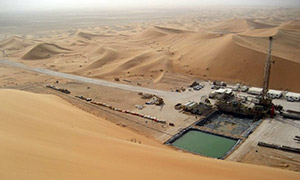Oil & Gas
 The first oil concession in Oman was granted in 1925, but commercial exports began in August 1967. Most of Oman’s 5.5bn barrels in oil reserves are located in the country’s northern and central regions. In the north, the Yibal, Natih, Fahud, al-Huwaisah and Lekhwair fields combined account for almost half of total Omani oil production. Northern oil is mostly found along with natural gas where as the southern oil, particularly from Nimr and Amal fields, is heavier and normally is not associated with natural gas.
The first oil concession in Oman was granted in 1925, but commercial exports began in August 1967. Most of Oman’s 5.5bn barrels in oil reserves are located in the country’s northern and central regions. In the north, the Yibal, Natih, Fahud, al-Huwaisah and Lekhwair fields combined account for almost half of total Omani oil production. Northern oil is mostly found along with natural gas where as the southern oil, particularly from Nimr and Amal fields, is heavier and normally is not associated with natural gas.
Since 1970, many other fields have been found and developed by Petroleum Development Oman (PDO) which holds over 90% of the country’s reserves and accounts for about 95% of crude-oil production and nearly all of its natural gas supply. PDO is a consortium comprised of the Omani government, Shell, Total and Partex.
At the end of 1999 production had risen to an average of nearly 850,000 barrels a day from nearly a hundred fields, compared with 300,000 barrels a day in 1970 from only four fields. Oman’s total exports of crude oil stood at 102 million barrels during the first five months of 2006. The hydrocarbon sector which is the mainstay of the Oman economy, accounts for over 73% of the country’s exports and constitute 42% of GDP.
Oil remaining the single most important source of revenue, but Oman has made Natural Gas the cornerstone of its diversification and economic growth strategy.
Oman’s production of natural gas rose by 28.2 per cent during the first six months of 2006 to reach 498,957 million m3. At present, about 300 million m3 are used, 80% in domestic consumption with electricity generation, 11% in PDO industries, the rest in other industrial activities.
Oman began exports of Liquefied Natural Gas in early 2000 in Qalhat. One of the biggest projects is the Oman Liquefied Natural Gas venture (Omani Government, Shell, Total, KOLNG, Partex, Mitsubishi, Mitsui and Itochu), which completed a US$2bn LNG plant at Sur. It produced a nominal 6.6 million tonnes of LNG per year from two LNG process trains. But Oman LNG expanded its capacity by 50% to 9.9mn tonnes per year by commissioning a third train in 2005.
Oman is continuing to develop its gas resources by expanding its LNG facilities and associated upstream infrastructure. The first oil concession in Oman was granted in 1925, but commercial exports began in August 1967. Most of Oman’s 5.5bn barrels in oil reserves are located in the country’s northern and central regions. In the north, the Yibal, Natih, Fahud, al-Huwaisah and Lekhwair fields combined account for almost half of total Omani oil production. Northern oil is mostly found along with natural gas where as the southern oil, particularly from Nimr and Amal fields, is heavier and normally is not associated with natural gas.
The first oil concession in Oman was granted in 1925, but commercial exports began in August 1967. Most of Oman’s 5.5bn barrels in oil reserves are located in the country’s northern and central regions. In the north, the Yibal, Natih, Fahud, al-Huwaisah and Lekhwair fields combined account for almost half of total Omani oil production. Northern oil is mostly found along with natural gas where as the southern oil, particularly from Nimr and Amal fields, is heavier and normally is not associated with natural gas.
Since 1970, many other fields have been found and developed by Petroleum Development Oman (PDO) which holds over 90% of the country’s reserves and accounts for about 95% of crude-oil production and nearly all of its natural gas supply. PDO is a consortium comprised of the Omani government, Shell, Total and Partex.
At the end of 1999 production had risen to an average of nearly 850,000 barrels a day from nearly a hundred fields, compared with 300,000 barrels a day in 1970 from only four fields. Oman’s total exports of crude oil stood at 102 million barrels during the first five months of 2006. The hydrocarbon sector which is the mainstay of the Oman economy, accounts for over 73% of the country’s exports and constitute 42% of GDP.
Oil remaining the single most important source of revenue, but Oman has made Natural Gas the cornerstone of its diversification and economic growth strategy.
Oman’s production of natural gas rose by 28.2 per cent during the first six months of 2006 to reach 498,957 million m3. At present, about 300 million m3 are used, 80% in domestic consumption with electricity generation, 11% in PDO industries, the rest in other industrial activities.
Oman began exports of Liquefied Natural Gas in early 2000 in Qalhat. One of the biggest projects is the Oman Liquefied Natural Gas venture (Omani Government, Shell, Total, KOLNG, Partex, Mitsubishi, Mitsui and Itochu), which completed a US$2bn LNG plant at Sur. It produced a nominal 6.6 million tonnes of LNG per year from two LNG process trains. But Oman LNG expanded its capacity by 50% to 9.9mn tonnes per year by commissioning a third train in 2005.
Oman is continuing to develop its gas resources by expanding its LNG facilities and associated upstream infrastructure.

